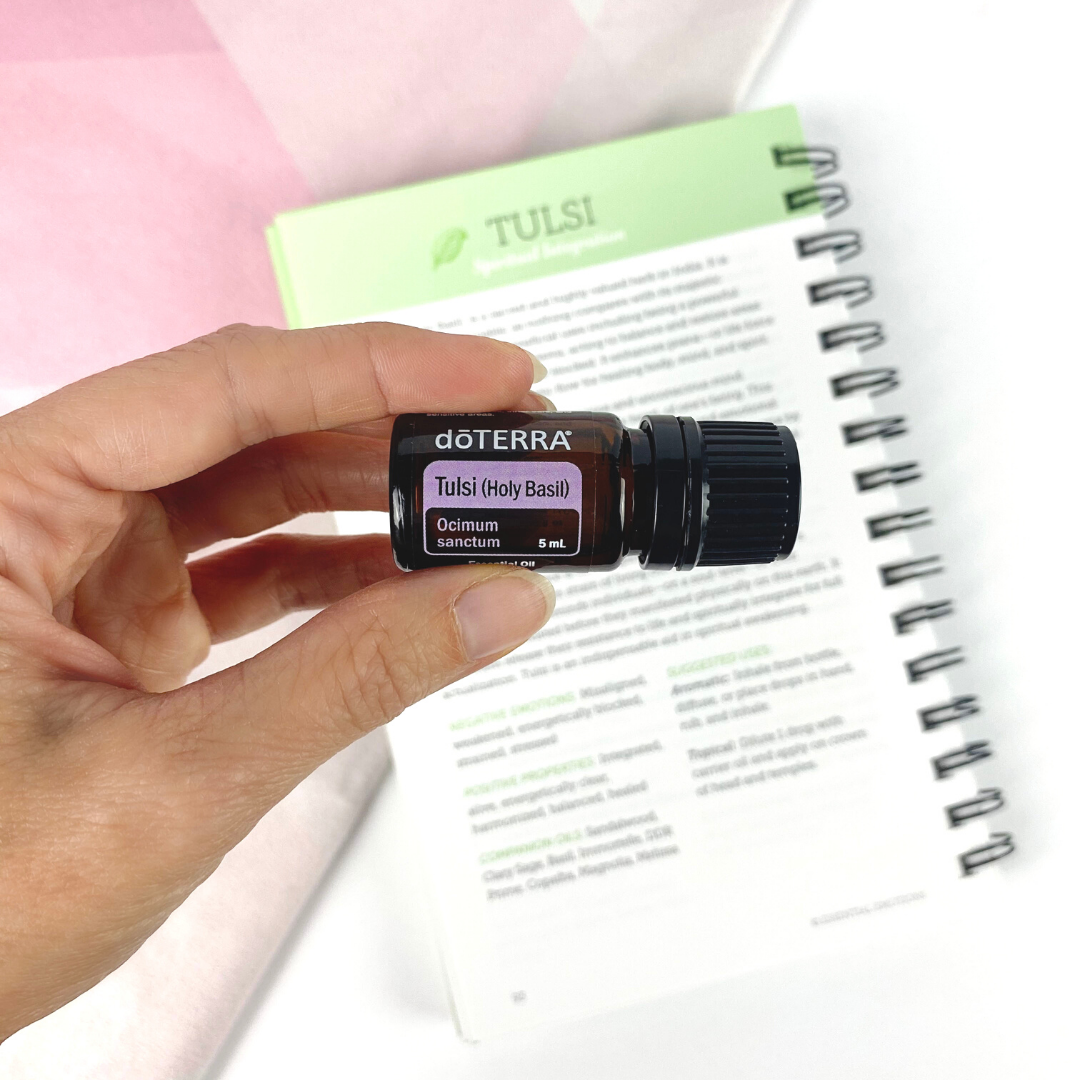
Native to Southeast Asia, this small, green, bushy shrub with pink and lavender-hued flowers is part of the mint family. It has a history within Indian health practices as a natural solution for many conditions. Tulsi (Holy Basil) meaning “the incomparable one,” is considered “Queen of the Herbs.” Experimental research suggests that eugenol and beta-caryophyllene, constituents of Tulsi, contribute to its cleansing properties and skin benefits. CPTG® Tulsi resembles a cross between traditional Basil oil and Clove oil. Reminiscent of freshly cut basil, the warm, sweet aroma creates an engaging atmosphere. It is traditionally used around the world as part of rituals and protection in many cultures. Apply to skin to help keep the appearance clean and healthy.

Tulsi (Holy Basil) Essential Oil Facts
| Botanical Name | Ocimum sanctum |
| Main Chemical Components | Eugenol, beta- caryophyllene, trans-beta-elemene, 1,8-Cineole |
| Aroma | Warm, spicy, balsamic |
| Note | Top |
| Extraction Method | Steam distillation |
| Plant Part Used | Leaves and Flowers/Buds |

How to Use Tulsi or Holy Basil
- Oral Rinse: Practice good oral hygiene with Tulsi essential oil. Simply add one drop of Tulsi oil to two ounces of water and gargle for clean and fresh breath.
- Skincare Routine: Add one drop of Tulsi oil to your facial cleanser or lotion as part of your daily skincare routine to help keep the appearance of your skin looking clean and healthy. For those with sensitive skin, dilute with a carrier oil before using topically.
- Personal Massage: Apply one to two drops of Tulsi essential oil and the carrier oil of your choice to your back, the bottoms of your feet, or various pulse points and gently massage for a soothing sensation on your skin accompanied by a warm, tranquil aroma.
- Steam Facial: For an aromatically soothing steam facial, simply add three to four drops of Tulsi oil in a bowl of hot water. Next, place a towel over your head and lean your face over the steam and delight in the rich, uplifting aroma.
- Afternoon Pick-Me-Up: For an afternoon pick-me-up, add one drop of Tulsi oil to the palm of your hand, then rub your hands together, and cup your hands over your nose and inhale the energising, soothing aroma.
- Diffusion: Add three to four drops of Tulsi oil in the diffuser of your choice to create a calming, inviting atmosphere throughout your home or office.
Tulsi essential oil can be used both topically and aromatically. Simple diffusion or inhalation is always a fabulous way to get the benefits of an oil aromatically, and the same is true for Tulsi. You might enjoy the scent of Tulsi alone or use it to create a diffuser blend that includes other oils too.
Topically, apply Holy Basil to your spine, bottoms of the feet, and pulse points. You can add a drop to your lotion as well.
Another way you can use Tulsi is in a mouthwash. Add a few drops to some water, gargle and swish, then spit it out. Not only is it great for oral hygiene, but it keeps your breath fresh.
Finally, you might enjoy making Tulsi part of a steam facial. You’ll enjoy both the aromatic and topical benefits simultaneously. Your skin will thank you and you will enjoy the soothing benefits as well!
Simply put several drops of Tulsi in a bowl of hot water. Place a towel over your head and lean your face over the steam. If it becomes too warm, you can lift part of the towel, move your face farther from the steam, or take a break for a few seconds. If you want to add other oils to the experience as well, Lavender, Frankincense, and dōTERRA Easy Air are all great options to pair with Tulsi.
What Are the Benefits of Tulsi or Holy Basil?
Traditionally, Tulsi has been used worldwide as in rituals, protection, and health practices. Tulsi’s main chemical constituents are eugenol, beta-caryophyllene, and trans-beta-elemene.
Tulsi has a high percentage of eugenol, which is also found in Clove essential oil. Eugenol helps keep the mouth looking clean and healthy. When applied topically, it also benefits healthy skin and has cleansing properties.
Now, let’s look at beta-caryophyllene. You may have heard of this constituent before. It’s famously present in Copaiba in large quantities, but it’s also part of other essential oils like Black Pepper, Clove, Melissa, and even Rosemary. Beta-caryophyllene is a sesquiterpene found in hundreds of different plant species. Its benefits are truly incredible.
What Does Tulsi Smell Like?
Compared to its cousin sweet basil, Holy Basil’s scent is more rich, warm, and balsamic. The aroma resembles something of a blend of cinnamon, peppermint, clove, and basil with a touch of licorice! Its aroma is warming, clarifying, and uplifting.


In abundance and with hope and blessings
Tracey
XoXo



